Social Media Blunders and How You Can Avoid Them

Image Source: freepik
The growing popularity of social media is encouraging every business to invest in it as a primary marketing channel. That’s because 46 percent of the global population is on some social channel or the other.
Besides connecting businesses to their target audience, social media broadens a brand’s reach and boosts its online reputation.

Source: We Are Social
However, social media is a double-edged sword that can make or devastate a business depending on how you use it.
More often than not, brands do not see the expected results from their social media strategy and don’t realize what they are doing wrong until it’s too late.
In this post, we have highlighted the top social media mistakes made by marketers. If you are committing any of these, it’s time to steer clear of them.
1. Poor Understanding of the Target Audience
One of the worst social media slip-ups is not allocating enough time to understand your followers and the type of content that resonates with them.
Consider these tips to better understand who you are talking to and how you can tailor your social messages for maximum impact.
i. Define Your Social Media Persona
Social media personas depict a brand’s ideal customer. Defining a persona will allow you to target content that’s most relevant and useful to your audience.
Gather demographic data about your audience using insights from social channels like Twitter, LinkedIn, and Facebook. Twitter Analytics, for instance, can offer you key audience demographics, interests, location, and languages.
Similarly, the ‘Audience Insights’ tool on Facebook for Business offers valuable user information, such as demographics, page likes, location, usage, and purchase activity among others.
Finally, use SEOPressor’s 5 simple steps to create a buyer persona to paint a picture of the audience you are planning to target.
ii. Determine Your Audience’s Favorite Social Media Platforms
Take time to learn the type of content your audience consumes. Do they like watching videos or read long-form posts? Do they prefer engaging in social conversations? How do they respond to promotional discounts?
The answers to these questions will help you get a rough idea of where your audience is most active. Secondly, tools like Keyhole can help you analyze hashtags and find out the channels your customer is on.
Check out the top posts for Kellogg’s #GreatStarts campaign. The free search bar on Keyhole helps you get a peek into the top social networks the hashtag was used on.
![]()
Source: Keyhole
iii. Get Insights from Your Competitor’s Strategy
Your competitors may have done the groundwork on understanding their target audience (which is your audience too!). Use competitor intelligence tools like BuzzSumo to analyze the top shared content and the most popular content type (videos, long-form articles, or infographics).
For instance, a fitness blogger launching a blog related to ‘yoga in pregnancy’ can use this tool to find out the best-performing social posts in this niche. Going through these posts will help them know the top content contributors and the type of content your target audience appreciates.
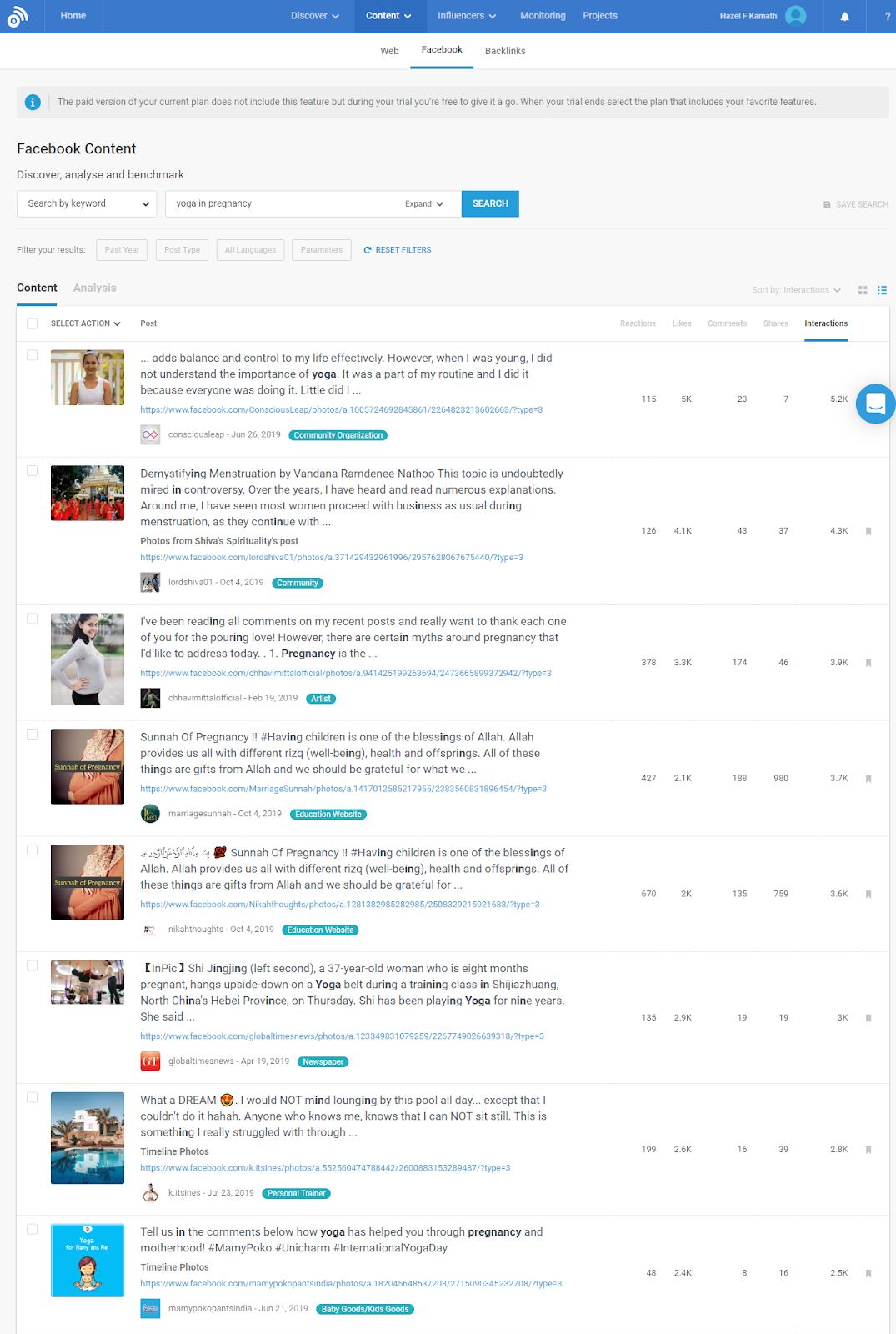
Buzzsumo – Content Intelligence Tool
iv. Validate Your Audience Profile
Finally, use online survey tools like SurveyMonkey or Typeform to verify your audience research. SurveyMonkey recently came up with a social networking survey template that can help marketers find out their audience’s favorite channel and content preferences.
Further, you can use UTM parameters to tag your social content and gather data on who is clicking or interacting with your posts. Here’s a handy guide from Hootsuite that shares effective tips on the subject.
2. Treating All Social Media Channels Equal
Each social platform is unique in more ways than one. They cater to different audiences with distinctive demographics, behaviors, and interests and offer varying features and marketing tools.
So, treating them as the same is probably the worst mistake you would be committing. Think about it – would you promote to the audience on TikTok the same way as your Twitter audience?
TikTokers are primarily Gen Zs who expect to see entertaining, relevant, and value-adding videos.
On the other hand, Twitter caters to different age groups and is essentially a content distributing tool where people share links and live updates and trigger conversations using hashtags.

Image Source: sproutsocial and Oberlo
Cross-posting often seems like a fast and convenient way to share special content on social media. However, blatantly copying and pasting the same content each day can significantly erode your user experience and engagement and create a negative perception of your business.
Avoid posting the same content across all social channels or multiple accounts on the same platform.
The content you post on different channels doesn’t have to drastically unique. Make enough changes to show that enough human effort has gone into tailoring the post for each channel. Bear these points in mind when reposting content on your social pages.
- Determine what kind of content will do well on each platform. For instance, hashtags and memes work well on Twitter while good-quality images and videos will engage your Instagram audience. So, even if most of your content is similar, try mixing up the format to engage your users.
- Change the headline or caption or use a different image to prevent your post from looking the same on all social sites. Sometimes, even the smallest change can make a big difference.
- Optimize your posts for each channel. Format your content, captions, handles, internal links, hashtag sets, and tags for each social platform. Platform-specific posts tend to stand out from the rest, enabling you to engage the users effectively.
- Schedule your posts for optimal viewing on each platform. Refer to the full infographic by SEOPressor. It shares information on the time of day and days of the week marketers should post to engage their audience in the best possible way.

A thorough social media platform analysis is critical to understand which ones are the most relevant ones for your business. Don’t miss this important step when planning your social strategy.
3. Not Being Human
People trust people more than faceless brands. If you are a faceless corporate merely posting content without a human touch, you aren’t going too far in the social world.
Social media is all about creating relatable posts that add make your brand more social. For instance, frequently posting photos of your employees, workplace, or behind-the-scenes can help humanize your brand and build an authentic relationship with your audience.
Slack, a cloud-based instant messaging platform, frequently shares photos and videos of their team, showing their audience that they are social creatures just anyone else.



Source: @slackhq
Similarly, adding live videos of events or ongoing projects can help your audience see that there’s a real human behind the brand, building trust and authenticity.
Finally, automate in moderation. Social media automation has its own pros and
cons. Though it helps organize content and schedules your posts to perfection, overusing it can make you look like a faceless content-distributing machine.
Use the 5-3-2 rule of social sharing to strike a balance between automation and the ‘human’ element in your posts.
The rule states that for every 10 posts on a social media channel:
 5 should be content from others
5 should be content from others 3 should be content from you
3 should be content from you 2 should be non-work related posts (like behind-the-scenes or fun events) to humanize your brand
2 should be non-work related posts (like behind-the-scenes or fun events) to humanize your brand

Image Source: Social Champ
4. Failing to Engage in Social Listening
Not engaging in social listening can make you miss out on opportunities to connect with your audience and convert them into leads.
Simply put, failing to engage in social listening = Lost Sales
Participating in brand-related conversations can also offer you interesting insights about your audience’s pressing issues and their views about the brands in your niche.
Moreover, social media users appreciate firms exhibiting promptness in response. Research shows that 42 percent of social media users expect a response within 60 minutes.
Hence, the time you take to respond to a brand mention plays a critical role in winning user trust and converting them into leads.
Check out how Best Buy wins customers just by being quick with their responses:
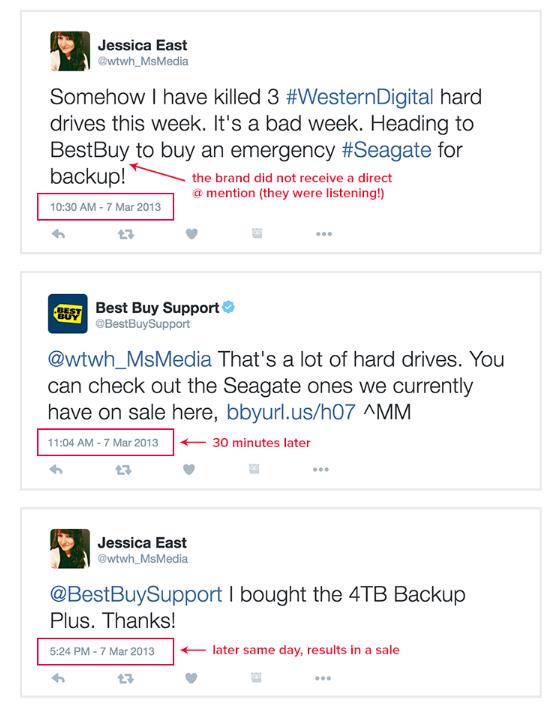
Image Source: FreshSparks
Most brands do not engage with social comments or brand mentions which is a grave mistake they make.
The following blunders often give followers the impression that brands aren’t interested in stirring up a conversation with the community.
i. Not Engaging with Followers
Brand mentions and comments are often scenarios where prospects become customers and existing users become fans or brand advocates. In fact, such comments are a great opportunity to connect with the audience.
Missing mentions, messages, or comments from users can prove to be fatal to your brand image. If you have a follower sharing their brand experience (positive, negative, or neutral), make sure you respond to them.
For instance, if you have a satisfied customer sharing a positive brand story, make sure you respond with – “I have been following your posts. Thank you for your kind words. I’m glad you like it!”
McDonald’s never fails to directly respond to its customers by addressing them in their tweets.
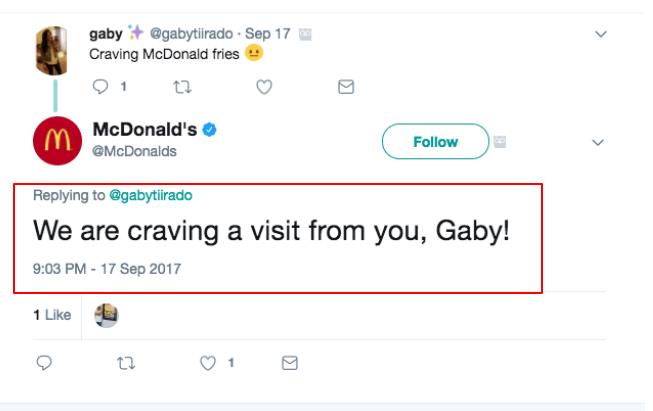
Source: Twitter
ii. Ignoring Neutral Mentions
What can one possibly derive from neutral mentions, you think? Well, neutral comments can offer you important brand insights that can be used to improve your marketing strategy.
Notice how this user compares Lays with the Doritos version of wasabi chips. Not only does it show that the customer is a Frito-Lay consumer (both Lays and Doritos belong to the Frito-Lay family) but also shares information about their favorite flavor, wasabi.
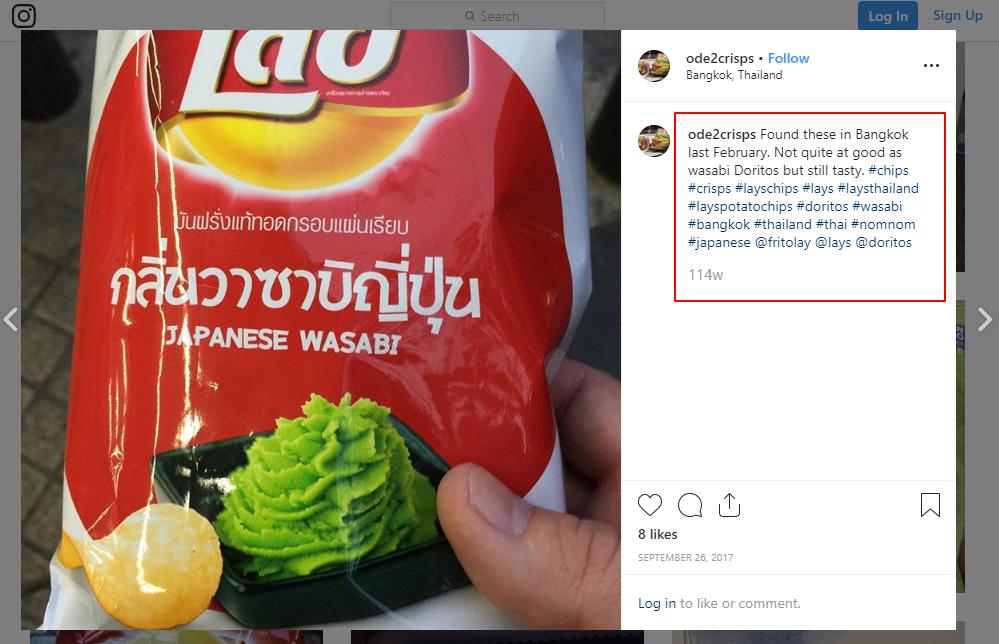
Source: Instagram
iii. Avoiding or Deleting Negative Comments
Don’t ignore negative mentions. Also, avoid being rude or deleting a comment that’s not in favor of your brand. All of this can give you a bad reputation.
A negative comment is an opportunity for you to offer a viable solution to the concerns raised and win the trust of your followers. Use these quick tips when responding to a negative social mention.
 Acknowledge the issue and apologize for the inconvenience caused.
Acknowledge the issue and apologize for the inconvenience caused. Be polite and offer solutions to help resolve the specific problem mentioned.
Be polite and offer solutions to help resolve the specific problem mentioned. If there are issues that cannot be resolved immediately, take it off the social channel by
If there are issues that cannot be resolved immediately, take it off the social channel by
asking the user to call or email you separately. If possible, offer a small token of appreciation to the user for sharing their valuable brand experience.
If possible, offer a small token of appreciation to the user for sharing their valuable brand experience.
Here’s an infographic by Brand24 that shares a six-step negative comment action plan.
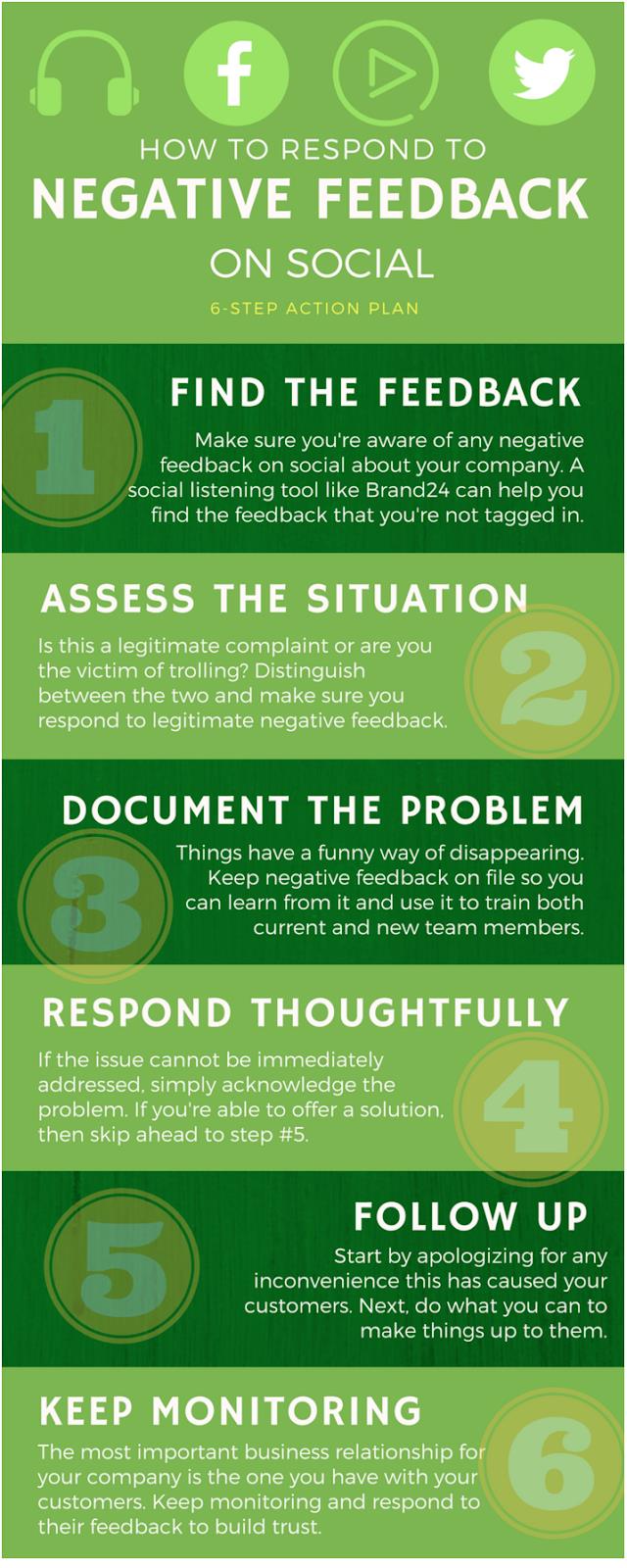
Source: Brand24
5. Ignoring the Power of Analytics
Social media analytics is the sure-shot way to evaluate your social strategies in real-time.
The insights derived can be used to tweak your campaigns on the go, gather competitive intelligence, and get maximum returns on investment.
Thus, being active on social media and not paying attention to the numbers is not merely a faux pas: it’s an intolerable offense that will cost you a lot of money and resources in the long term.
Measure the impact of your social media efforts and spending using the below-mentioned tools.
- BuzzSumo is an excellent tool to analyze social engagement for a piece of content. As seen earlier in this post, BuzzSumo can instantly share insights on the number of shares and likes a post has received on Facebook, Twitter, or LinkedIn.
- Awario is a social listening tool that specializes in tracking brand mentions and conversations. It offers real-time insights into industry conversations by analyzing keywords related to a business or niche.
- Keyhole is a real-time hashtag tracking tool for social channels like Twitter, Instagram, and Facebook. It also helps you understand how each influencer is impacting your social campaigns and end goals.
- Sprout Social is a cross-channel social analytics tool that can track and evaluate Facebook page impressions, LinkedIn engagement, Instagram followers, and Twitter clicks. It also organizes the data into an easy-to-understand report that helps you keep a track of the core social metrics.
A few other tools like TapInfluence, Snaplytics, Social Status, and Quintly can also offer interesting performance insights, allowing you to draw actionable ideas to boost your social media performance.
- The following point was added by SEOPressor Connect editorial team
6. Not Adding Schemas for Social Sharing
As businesses, we all want our posts to get engagements and sometimes, shares. If you want to share your webpage on social media, there’s one thing that you need to look into.
Adding lines of schema markup to your webpage.
So, what these lines of schema markup do is it gives users a better idea of what the link is about. It will show the page’s featured image, title, as well as the description.
Below, you’ll be able to see how the links appear on Facebook and Twitter, with and without the markup.
On Facebook:
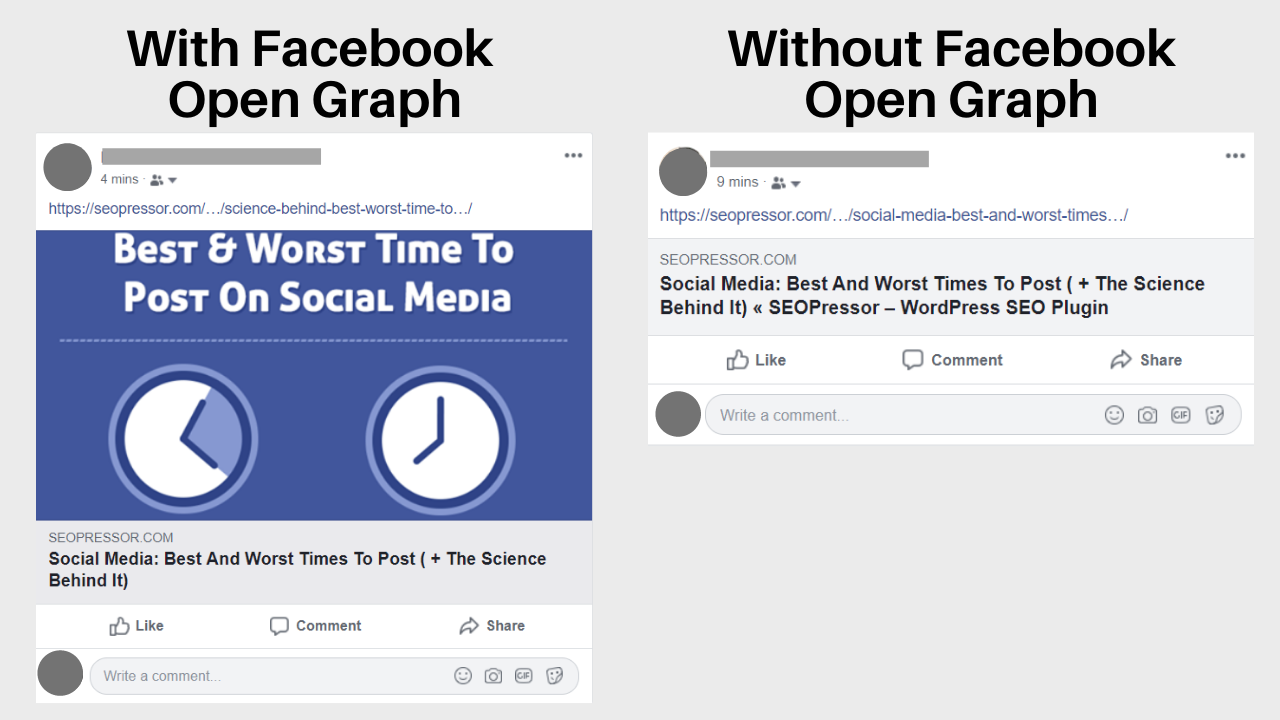
With and without Facebook OpenGraph
On Twitter:

With and without Twitter Card
Generally, people will be more inclined to click on your link as well as share your posts if it’s clear what the link is about. I’m sure you’re more inclined to click the ones with markup as well.
So, start getting more engagements on social media by adding social markups.
You can learn more about the markups below:
Facebook Open Graph Markup
Twitter Cards
Alternatively, consider using SEOPressor Connect WordPress SEO plugin to add them in easily. All you need to do is enter information in respective fields and the markup will be added to your page.

SEOPressor’s Social Markup
Use SEOPressor today: subscribe
Summing Up
Everyone’s jumping on the social media bandwagon but very few take the time to analyze what’s working for them and what’s not. Too many slip-ups in the social media realm can adversely affect your brand reputation and revenue stream.
To err is human. But what’s important is to identify these blunders and take lessons from to avoid them in the future. Follow this list of big no-no’s to up your social media game and put your business on the fast track to success.
- This article is contributed by Pratik Dholakiya.
About the Author:
Pratik Dholakiya is the founder of The 20 Media, a content marketing agency specializing in content & data-driven SEO. He regularly speaks at various conferences about SEO, content marketing, entrepreneurship, and digital PR.
Pratik has spoken at the 80th Annual Conference of Florida Public Relations Association, Accounting & Finance Show, Singapore, NextBigWhat’s UnPluggd, IIT-Bombay, SMX Israel, SEMrush Meetup, MICA, IIT-Roorkee, and other major events.
As a passionate SEO & content marketer, he shares his thoughts and knowledge in publications like Search Engine Land, Search Engine Journal, Entrepreneur Magazine, Fast Company, The Next Web, YourStory and Inc42, to name a few. Find him on Twitter @DholakiyaPratik
#optin-template-3{
float: left;
margin: 0;
width: 100%;
max-width: 654px;
height: 100%;
}
#optin-template-3 .container{
float: left;
width: 100%;
height: 100%;
text-align: center;
background: #fff;
padding-bottom: 16px;
}
#optin-template-3 .top-row{
display: inline-block;
width: 88%;
padding: 3% 6% 0%;
}
#optin-template-3 .top-row h2{
margin: 5px 0 0;
font-family: “roboto”, helvetica, sans-serif;
color:#6490CC;
font-weight: 600;
text-align: center;
padding:0px 0px 5px;
font-size:2.2em;
}
#optin-template-3 .left-column{
display: inline-block;
width: 100%;
max-width: 270px;
min-width: 270px;
height: 100%;
vertical-align: top;
padding-top: 32px;
}
#optin-template-3 .ebook-img{
width: 100%;
min-width:270px;
height: 280px;
background: url(https://seopressor.com/wp-content/uploads/2019/10/Checklist-to-Increase-Social-Media-Engagement.png);
background-size: contain;
background-repeat: no-repeat;
}
#optin-template-3 .right-column{
display: inline-block;
width: 60%;
min-width: 250px;
max-width: 305px;
padding: 24px 4% 32px;
}
#optin-template-3 .bodycopy ul{
text-align: left;
padding-left: 0;
}
#optin-template-3 .bodycopy ul li{
font-family: “roboto”, helvetica, sans-serif;
margin-left: 20px;
}
#optin-template-3 .optIn-form{
display: block;
}
#optin-template-3 .email{
display: block;
width: 100%;
border: 0;
padding: 8px 0;
font-size: 18px;
text-align: center;
border: 1px solid #6490CC;
}
#optin-template-3 .submit-button{
display: block;
margin-top: 4%;
width: 100%;
padding: 8px 0;
font-family: “roboto”, helvetica, sans-serif;
font-weight: 400;
color: #fff;
background: #6490CC;
font-size: 21px;
border: 0;
outline: 1px solid #6490CC;
cursor: pointer;
}
#optin-template-3 .container .align-justify { text-align:justify !important;}
Get 10X Like On Facebook And More!
- Want to increase your social media profile engagement?
We have created a simple checklist for you to tick off.
“Great checklist, gives me tons of suggestions to improve my social marketing that I could never have thought of. I’m gonna work on checking the whole list off now!” – Ryan Godfrey
